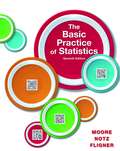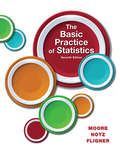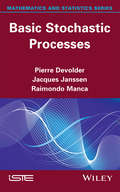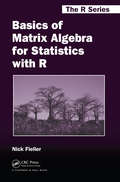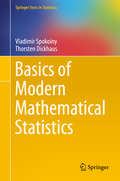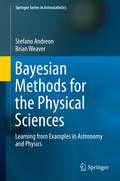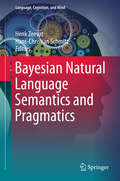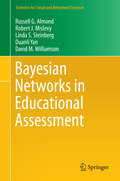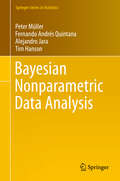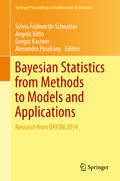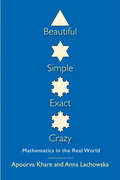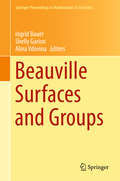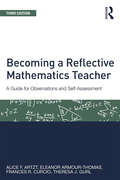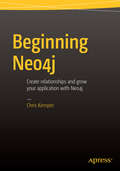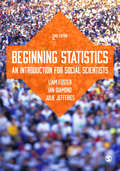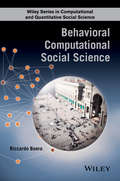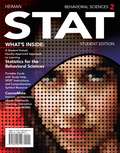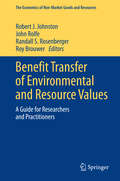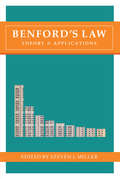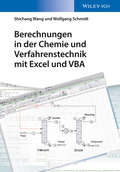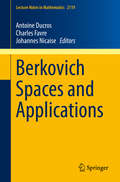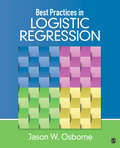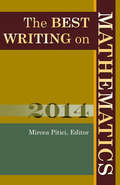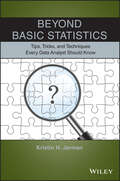- Table View
- List View
The Basic Practice Of Statistics
by David S. Moore William I. Notz Michael A. FlignerDavid Moore's data analysis (conceptual) approach, which revolutionized the introductory statistics textbook, moves students away from formulas and number-crunching, focusing instead on how working statisticians in a variety of fields collect and analyze data, and use the results to tackle real-world problems. The clear, direct way of emphasizing the course's relevance and confronting students' math anxieties is at the heart of the bestselling The Basic Practice of Statistics (BPS). It is also the ideal approach for taking full advantage of the powerful statistical tools and interactive learning features in this new edition's text/media package. Now more than ever, BPS is ready to help students move from reading about statistical practice to practicing statistics themselves. What's in the LaunchPad
The Basic Practice of Statistics: Test Bank
by David S. Moore William I. Notz Michael A. FlignerDavid Moore's data analysis (conceptual) approach, which revolutionized the introductory statistics textbook, moves students away from formulas and number-crunching, focusing instead on how working statisticians in a variety of fields collect and analyze data, and use the results to tackle real-world problems. The clear, direct way of emphasizing the course's relevance and confronting students' math anxieties is at the heart of the bestselling The Basic Practice of Statistics (BPS). It is also the ideal approach for taking full advantage of the powerful statistical tools and interactive learning features in this new edition's text/media package. Now more than ever, BPS is ready to help students move from reading about statistical practice to practicing statistics themselves. What's in the LaunchPad
Basic Stochastic Processes
by Raimondo Manca Jacques Janssen Pierre DevolderThis book presents basic stochastic processes, stochastic calculus including Lévy processes on one hand, and Markov and Semi Markov models on the other. From the financial point of view, essential concepts such as the Black and Scholes model, VaR indicators, actuarial evaluation, market values, fair pricing play a central role and will be presented. The authors also present basic concepts so that this series is relatively self-contained for the main audience formed by actuaries and particularly with ERM (enterprise risk management) certificates, insurance risk managers, students in Master in mathematics or economics and people involved in Solvency II for insurance companies and in Basel II and III for banks.
Basics of Matrix Algebra for Statistics with R (Chapman & Hall/CRC The R Series #31)
by Nick FiellerA Thorough Guide to Elementary Matrix Algebra and Implementation in R Basics of Matrix Algebra for Statistics with R provides a guide to elementary matrix algebra sufficient for undertaking specialized courses, such as multivariate data analysis and linear models. It also covers advanced topics, such as generalized inverses of singular and rectangular matrices and manipulation of partitioned matrices, for those who want to delve deeper into the subject. The book introduces the definition of a matrix and the basic rules of addition, subtraction, multiplication, and inversion. Later topics include determinants, calculation of eigenvectors and eigenvalues, and differentiation of linear and quadratic forms with respect to vectors. The text explores how these concepts arise in statistical techniques, including principal component analysis, canonical correlation analysis, and linear modeling. In addition to the algebraic manipulation of matrices, the book presents numerical examples that illustrate how to perform calculations by hand and using R. Many theoretical and numerical exercises of varying levels of difficulty aid readers in assessing their knowledge of the material. Outline solutions at the back of the book enable readers to verify the techniques required and obtain numerical answers. Avoiding vector spaces and other advanced mathematics, this book shows how to manipulate matrices and perform numerical calculations in R. It prepares readers for higher-level and specialized studies in statistics.
Basics of Modern Mathematical Statistics: Exercises And Solutions (Springer Texts in Statistics)
by Thorsten Dickhaus Vladimir SpokoinyThis textbook provides a unified and self-contained presentation of the main approaches to and ideas of mathematical statistics. It collects the basic mathematical ideas and tools needed as a basis for more serious study or even independent research in statistics. The majority of existing textbooks in mathematical statistics follow the classical asymptotic framework. Yet, as modern statistics has changed rapidly in recent years, new methods and approaches have appeared. The emphasis is on finite sample behavior, large parameter dimensions, and model misspecifications. The present book provides a fully self-contained introduction to the world of modern mathematical statistics, collecting the basic knowledge, concepts and findings needed for doing further research in the modern theoretical and applied statistics. This textbook is primarily intended for graduate and postdoc students and young researchers who are interested in modern statistical methods.
Bayesian Evolutionary Analysis with BEAST
by Alexei J. Drummond Remco R. BouckaertWhat are the models used in phylogenetic analysis and what exactly is involved in Bayesian evolutionary analysis using Markov chain Monte Carlo (MCMC) methods? How can you choose and apply these models, which parameterisations and priors make sense, and how can you diagnose Bayesian MCMC when things go wrong? These are just a few of the questions answered in this comprehensive overview of Bayesian approaches to phylogenetics. This practical guide: - Addresses the theoretical aspects of the field - Advises on how to prepare and perform phylogenetic analysis - Helps with interpreting analyses and visualisation of phylogenies - Describes the software architecture - Helps developing BEAST 2. 2 extensions to allow these models to be extended further. With an accompanying website providing example files and tutorials (http://beast2. org/), this one-stop reference to applying the latest phylogenetic models in BEAST 2 will provide essential guidance for all users - from those using phylogenetic tools, to computational biologists and Bayesian statisticians.
Bayesian Methods for the Physical Sciences: Learning from Examples in Astronomy and Physics (Springer Series in Astrostatistics #4)
by Stefano Andreon Brian WeaverStatistical literacy is critical for the modern researcher in Physics and Astronomy. This book empowers researchers in these disciplines by providing the tools they will need to analyze their own data. Chapters in this book provide a statistical base from which to approach new problems, including numerical advice and a profusion of examples. The examples are engaging analyses of real-world problems taken from modern astronomical research. The examples are intended to be starting points for readers as they learn to approach their own data and research questions. Acknowledging that scientific progress now hinges on the availability of data and the possibility to improve previous analyses, data and code are distributed throughout the book. The JAGS symbolic language used throughout the book makes it easy to perform Bayesian analysis and is particularly valuable as readers may use it in a myriad of scenarios through slight modifications. This book is comprehensive, well written, and will surely be regarded as a standard text in both astrostatistics and physical statistics. Joseph M. Hilbe, President, International Astrostatistics Association, Professor Emeritus, University of Hawaii, and Adjunct Professor of Statistics, Arizona State University
Bayesian Natural Language Semantics and Pragmatics (Language, Cognition, and Mind #2)
by Henk Zeevat Hans-Christian SchmitzThe contributions in this volume focus on the Bayesian interpretation of natural languages, which is widely used in areas of artificial intelligence, cognitive science, and computational linguistics. This is the first volume to take up topics in Bayesian Natural Language Interpretation and make proposals based on information theory, probability theory, and related fields. The methodologies offered here extend to the target semantic and pragmatic analyses of computational natural language interpretation. Bayesian approaches to natural language semantics and pragmatics are based on methods from signal processing and the causal Bayesian models pioneered by especially Pearl. In signal processing, the Bayesian method finds the most probable interpretation by finding the one that maximizes the product of the prior probability and the likelihood of the interpretation. It thus stresses the importance of a production model for interpretation as in Grice's contributions to pragmatics or in interpretation by abduction.
Bayesian Networks in Educational Assessment (Statistics for Social and Behavioral Sciences)
by Russell G. Almond Robert J. Mislevy Linda S. Steinberg Duanli Yan David M. WilliamsonBayesian inference networks, a synthesis of statistics and expert systems, have advanced reasoning under uncertainty in medicine, business, and social sciences. This innovative volume is the first comprehensive treatment exploring how they can be applied to design and analyze innovative educational assessments. Part I develops Bayes nets' foundations in assessment, statistics, and graph theory, and works through the real-time updating algorithm. Part II addresses parametric forms for use with assessment, model-checking techniques, and estimation with the EM algorithm and Markov chain Monte Carlo (MCMC). A unique feature is the volume's grounding in Evidence-Centered Design (ECD) framework for assessment design. This "design forward" approach enables designers to take full advantage of Bayes nets' modularity and ability to model complex evidentiary relationships that arise from performance in interactive, technology-rich assessments such as simulations. Part III describes ECD, situates Bayes nets as an integral component of a principled design process, and illustrates the ideas with an in-depth look at the BioMass project: An interactive, standards-based, web-delivered demonstration assessment of science inquiry in genetics. This book is both a resource for professionals interested in assessment and advanced students. Its clear exposition, worked-through numerical examples, and demonstrations from real and didactic applications provide invaluable illustrations of how to use Bayes nets in educational assessment. Exercises follow each chapter, and the online companion site provides a glossary, data sets and problem setups, and links to computational resources.
Bayesian Nonparametric Data Analysis (Springer Series in Statistics)
by Peter Müller Fernando Andres Quintana Alejandro Jara Tim HansonThis book reviews nonparametric Bayesian methods and models that have proven useful in the context of data analysis. Rather than providing an encyclopedic review of probability models, the book's structure follows a data analysis perspective. As such, the chapters are organized by traditional data analysis problems. In selecting specific nonparametric models, simpler and more traditional models are favored over specialized ones. The discussed methods are illustrated with a wealth of examples, including applications ranging from stylized examples to case studies from recent literature. The book also includes an extensive discussion of computational methods and details on their implementation. R code for many examples is included in online software pages.
Bayesian Statistics from Methods to Models and Applications: Research from BAYSM 2014 (Springer Proceedings in Mathematics & Statistics #126)
by Sylvia Frühwirth-Schnatter Angela Bitto Gregor Kastner Alexandra PosekanyThe Second Bayesian Young Statisticians Meeting (BAYSM 2014) and the research presented here facilitate connections among researchers using Bayesian Statistics by providing a forum for the development and exchange of ideas. WU Vienna University of Business and Economics hosted BAYSM 2014 from September 18th to the 19th. The guidance of renowned plenary lecturers and senior discussants is a critical part of the meeting and this volume, which follows publication of contributions from BAYSM 2013. The meeting's scientific program reflected the variety of fields in which Bayesian methods are currently employed or could be introduced in the future. Three brilliant keynote lectures by Chris Holmes (University of Oxford), Christian Robert (Université Paris-Dauphine), and Mike West (Duke University), were complemented by 24 plenary talks covering the major topics Dynamic Models, Applications, Bayesian Nonparametrics, Biostatistics, Bayesian Methods in Economics, and Models and Methods, as well as a lively poster session with 30 contributions. Selected contributions have been drawn from the conference for this book. All contributions in this volume are peer-reviewed and share original research in Bayesian computation, application, and theory.
Beautiful, Simple, Exact, Crazy: Mathematics in the Real World
by Apoorva Khare Anne LachowskaTwo mathematicians explore how math fits into everything from art, music, and literature to space probes and game shows.In this vibrant work, which is ideal for both teaching and learning, Apoorva Khare and Anna Lachowska explain the mathematics essential for understanding and appreciating our quantitative world. They show with examples that mathematics is a key tool in the creation and appreciation of art, music, and literature, not just science and technology. The book covers basic mathematical topics from logarithms to statistics, but the authors eschew mundane finance and probability problems. Instead, they explain how modular arithmetic helps keep our online transactions safe, how logarithms justify the twelve-tone scale commonly used in music, and how transmissions by deep space probes are like knights serving as messengers for their traveling prince.Perfect for coursework in introductory mathematics and requiring no knowledge of calculus, Khare and Lachowska&’s enlightening mathematics tour will appeal to a wide audience.&“A whirlwind tour through mathematics and its applications to the real world, laced with stimulating exercises and fascinating historical insights. Destined to become a classic of mathematical exposition.&” —Eli Maor, author of e: the Story of a Number and Trigonometric Delights&“Khare and Lachowska introduce bite-size pieces of important math by surrounding them with interesting context, from the Monty Hall problem for probability to a story by Dino Buzzati for velocity. Math treated with seriousness and fun.&” —Michael Frame, co-author, with Benoit Mandelbrot, of Fractals, Graphics, and Mathematics Education&“An excellent book, well-suited for a thoughtful, quantitatively-rigorous &‘Math for Humanists&’ course.&” —William Goldbloom Bloch, author of The Unimaginable Mathematics of Borges&’ Library of Babel
Beauville Surfaces and Groups (Springer Proceedings in Mathematics & Statistics #123)
by Ingrid Bauer Shelly Garion Alina VdovinaThis collection of surveys and research articles explores a fascinating class of varieties: Beauville surfaces. It is the first time that these objects are discussed from the points of view of algebraic geometry as well as group theory. The book also includes various open problems and conjectures related to these surfaces. Beauville surfaces are a class of rigid regular surfaces of general type, which can be described in a purely algebraic combinatoric way. They play an important role in different fields of mathematics like algebraic geometry, group theory and number theory. The notion of Beauville surface was introduced by Fabrizio Catanese in 2000 and after the first systematic study of these surfaces by Ingrid Bauer, Fabrizio Catanese and Fritz Grunewald, there has been an increasing interest in the subject. These proceedings reflect the topics of the lectures presented during the workshop 'Beauville surfaces and groups 2012', held at Newcastle University, UK in June 2012. This conference brought together, for the first time, experts of different fields of mathematics interested in Beauville surfaces.
Becoming a Reflective Mathematics Teacher: A Guide for Observations and Self-Assessment (Studies in Mathematical Thinking and Learning Series)
by Alice F. Artzt Eleanor Armour-Thomas Frances R. Curcio Theresa J. GurlIdeal for preservice mathematics teachers who are taking methods courses or are student teaching, this research-based, activity-oriented guide offers a highly effective framework for teacher reflection and self-assessment. Highlighting inquiry-based, learner-centered teaching and grounded in a cognitive perspective, Becoming a Reflective Teacher of Mathematics, Third Edition features: Detailed observation instruments for observing other teachers Reflective activities that provide a structure for beginning teachers to think about their teaching Guidelines and instruments for supervisors to use when observing, conferencing with, and assessing beginning or student teachers The Third Edition of Becoming a Reflective Teacher of Mathematics is aligned with the latest standards for teaching mathematics including the Common Core State Standards-Mathematics, and the latest assessments for mathematics teacher certification which place a high priority on reflective practice. Thoroughly revised and updated throughout, the Third Edition continues to provide preservice and in-service mathematics teachers with practical ideas for developing and honing reflective and self-analytical skills needed to advance and improve instruction.
Beginning Neo4j
by Chris KemperThis book is your introduction in the world of graph databases, and the benefits they can bring to your applications. Neo4j is the most established graph database on the market, and it's always improving to bring more of its benefits to you. Beginning Neo4j will take you from the installation of Neo4j through to building a full application with Neo4j at its heart, and everything in between. Using this book, you'll get everything up and running, and then learn how to use Neo4j to build up recommendations, relationships, and calculate the shortest route between two locations. With example data models, and an application putting everything together, this book will give you everything you need to really get started with Neo4j. Neo4j is being used by social media and ecommerce industry giants. You can take advantage of Neo4j's powerful features and benefits - add Beginning Neo4j to your library today. What you'll learn Learn what Neo4j is and methods on how to install it Using Cypher, Neo4js query language to retrieve data Example data structures to help shape your application How to create relationships and recommendations between data Create an application that uses PHP and Neo4j together Taking your new Neo4j application into production Use Neo4j to calculate the shortest path between two locations Who this book is for This book is for anyone who wants to get started with graph databases, and doesn't know where to start. Table of Contents Chapter One: Introduction to Graph Databases Chapter Two: Getting to Know Neo4j Chapter Three: Get Up and Running with Neo4j Chapter Four: Meet Cypher Chapter Five: Managing Your Data in Neo4j Chapter Six: Importing and Exporting Data Chapter Seven: Using Data in Neo4j Chapter Eight: Building an App in Neo4j Chapter Nine: Neo4j in Production
Beginning Statistics: An Introduction for Social Scientists
by Liam Foster Ian Diamond Julie BantonIn the Second Edition of this bestselling textbook, the authors use real-world examples to introduce basic principles in statistics with no prior knowledge or experience assumed. With an emphasis on describing concepts, showing through example and illustrating points with graphs and displays, this book will provide readers with a step-by-step introduction to using statistics. Chapters address the following questions: Why bother learning statistics in the first place and are they relevant to real life? How do I make sensible tables and informative graphs? What are descriptive and inferential statistics and how are they used? What are regression and correlation anyway?
Behavioral Computational Social Science (Wiley Series in Computational and Quantitative Social Science)
by Riccardo BoeroThis book is organized in two parts: the first part introduces the reader to all the concepts, tools and references that are required to start conducting research in behavioral computational social science. The methodological reasons for integrating the two approaches are also presented from the individual and separated viewpoints of the two approaches.The second part of the book, presents all the advanced methodological and technical aspects that are relevant for the proposed integration. Several contributions which effectively merge the computational and the behavioral approaches are presented and discussed throughout
Behavioral Sciences STAT (New, Engaging Titles from 4LTR Press)
by Gary Heiman4LTR Press solutions give students the option to choose the format that best suits their learning preferences. This option is perfect for those students who focus on the textbook as their main course resource.
Benefit Transfer of Environmental and Resource Values: A Guide for Researchers and Practitioners (The Economics of Non-Market Goods and Resources #14)
by John Rolfe Roy Brouwer Robert J. Johnston Randall S. RosenbergerThis book provides a comprehensive review of environmental benefit transfer methods, issues and challenges, covering topics relevant to researchers and practitioners. Early chapters provide accessible introductory materials suitable for non-economists. These chapters also detail how benefit transfer is used within the policy process. Later chapters cover more advanced topics suited to valuation researchers, graduate students and those with similar knowledge of economic and statistical theory and methods. This book provides the most complete coverage of environmental benefit transfer methods available in a single location. The book targets a wide audience, including undergraduate and graduate students, practitioners in economics and other disciplines looking for a one-stop handbook covering benefit transfer topics and those who wish to apply or evaluate benefit transfer methods. It is designed for those both with and without training in economics
Benford's Law
by Steven J. MillerBenford's law states that the leading digits of many data sets are not uniformly distributed from one through nine, but rather exhibit a profound bias. This bias is evident in everything from electricity bills and street addresses to stock prices, population numbers, mortality rates, and the lengths of rivers. Here, Steven Miller brings together many of the world's leading experts on Benford's law to demonstrate the many useful techniques that arise from the law, show how truly multidisciplinary it is, and encourage collaboration.Beginning with the general theory, the contributors explain the prevalence of the bias, highlighting explanations for when systems should and should not follow Benford's law and how quickly such behavior sets in. They go on to discuss important applications in disciplines ranging from accounting and economics to psychology and the natural sciences. The contributors describe how Benford's law has been successfully used to expose fraud in elections, medical tests, tax filings, and financial reports. Additionally, numerous problems, background materials, and technical details are available online to help instructors create courses around the book.Emphasizing common challenges and techniques across the disciplines, this accessible book shows how Benford's law can serve as a productive meeting ground for researchers and practitioners in diverse fields.
Berechnungen in der Chemie und Verfahrenstechnik mit Excel und VBA
by Wolfgang Schmidt Shichang WangMit diesem Arbeitsbuch lernt der Anwender numerische Methoden in Excel-VBA kennen und zur Lösung von Problemen und Aufgabenstellungen aus Chemie und Verfahrenstechnik einzusetzen. Dabei steht die Anwendung auf einfache, grundlegende verfahrenstechnische Berechnungsmethoden im Vordergrund. Nach einer kurzen Einführung in Excel, Makros und die VBA-Programmierung, werden mathematische Methoden behandelt, die zur Berechnung verfahrenstechnischer und chemischer Problemstellungen erforderlich sind. Das Kernstück dieses Bandes ist die Anwendung des Gelernten auf reale Probleme aus dem Laboralltag, z.B. Gasgleichungen, Verbrennungs- und Polymerisationsrechnung.
Berkovich Spaces and Applications (Lecture Notes in Mathematics #2119)
by Johannes Nicaise Antoine Ducros Charles FavreWe present an introduction to Berkovich's theory of non-archimedean analytic spaces that emphasizes its applications in various fields. The first part contains surveys of a foundational nature, including an introduction to Berkovich analytic spaces by M. Temkin, and to étale cohomology by A. Ducros, as well as a short note by C. Favre on the topology of some Berkovich spaces. The second part focuses on applications to geometry. A second text by A. Ducros contains a new proof of the fact that the higher direct images of a coherent sheaf under a proper map are coherent, and B. Rémy, A. Thuillier and A. Werner provide an overview of their work on the compactification of Bruhat-Tits buildings using Berkovich analytic geometry. The third and final part explores the relationship between non-archimedean geometry and dynamics. A contribution by M. Jonsson contains a thorough discussion of non-archimedean dynamical systems in dimension 1 and 2. Finally a survey by J. -P. Otal gives an account of Morgan-Shalen's theory of compactification of character varieties. This book will provide the reader with enough material on the basic concepts and constructions related to Berkovich spaces to move on to more advanced research articles on the subject. We also hope that the applications presented here will inspire the reader to discover new settings where these beautiful and intricate objects might arise.
Best Practices in Logistic Regression
by Jason W. OsborneJason W. Osborne’s Best Practices in Logistic Regression provides students with an accessible, applied approach that communicates logistic regression in clear and concise terms. The book effectively leverages readers’ basic intuitive understanding of simple and multiple regression to guide them into a sophisticated mastery of logistic regression. Osborne’s applied approach offers students and instructors a clear perspective, elucidated through practical and engaging tools that encourage student comprehension.
The Best Writing on Mathematics 2014
by Mircea PiticiThis annual anthology brings together the year's finest mathematics writing from around the world. Featuring promising new voices alongside some of the foremost names in the field, The Best Writing on Mathematics 2014 makes available to a wide audience many articles not easily found anywhere else—and you don’t need to be a mathematician to enjoy them. These writings offer surprising insights into the nature, meaning, and practice of mathematics today. They delve into the history, philosophy, teaching, and everyday occurrences of math, and take readers behind the scenes of today’s hottest mathematical debates. Here John Conway presents examples of arithmetical statements that are almost certainly true but likely unprovable; Carlo Séquin explores, compares, and illustrates distinct types of one-sided surfaces known as Klein bottles; Keith Devlin asks what makes a video game good for learning mathematics and shows why many games fall short of that goal; Jordan Ellenberg reports on a recent breakthrough in the study of prime numbers; Stephen Pollard argues that mathematical practice, thinking, and experience transcend the utilitarian value of mathematics; and much, much more.In addition to presenting the year’s most memorable writings on mathematics, this must-have anthology includes an introduction by editor Mircea Pitici. This book belongs on the shelf of anyone interested in where math has taken us—and where it is headed.
Beyond Basic Statistics
by Kristin H. JarmanFeatures basic statistical concepts as a tool for thinking critically, wading through large quantities of information, and answering practical, everyday questions Written in an engaging and inviting manner, Beyond Basic Statistics: Tips, Tricks, and Techniques Every Data Analyst Should Know presents the more subjective side of statistics--the art of data analytics. Each chapter explores a different question using fun, common sense examples that illustrate the concepts, methods, and applications of statistical techniques. Without going into the specifics of theorems, propositions, or formulas, the book effectively demonstrates statistics as a useful problem-solving tool. In addition, the author demonstrates how statistics is a tool for thinking critically, wading through large volumes of information, and answering life's important questions. Beyond Basic Statistics: Tips, Tricks, and Techniques Every Data Analyst Should Know also features: Plentiful examples throughout aimed to strengthen readers' understanding of the statistical concepts and methods A step-by-step approach to elementary statistical topics such as sampling, hypothesis tests, outlier detection, normality tests, robust statistics, and multiple regression A case study in each chapter that illustrates the use of the presented techniques Highlights of well-known shortcomings that can lead to false conclusions An introduction to advanced techniques such as validation and bootstrapping Featuring examples that are engaging and non-application specific, the book appeals to a broad audience of students and professionals alike, specifically students of undergraduate statistics, managers, medical professionals, and anyone who has to make decisions based on raw data or compiled results.
